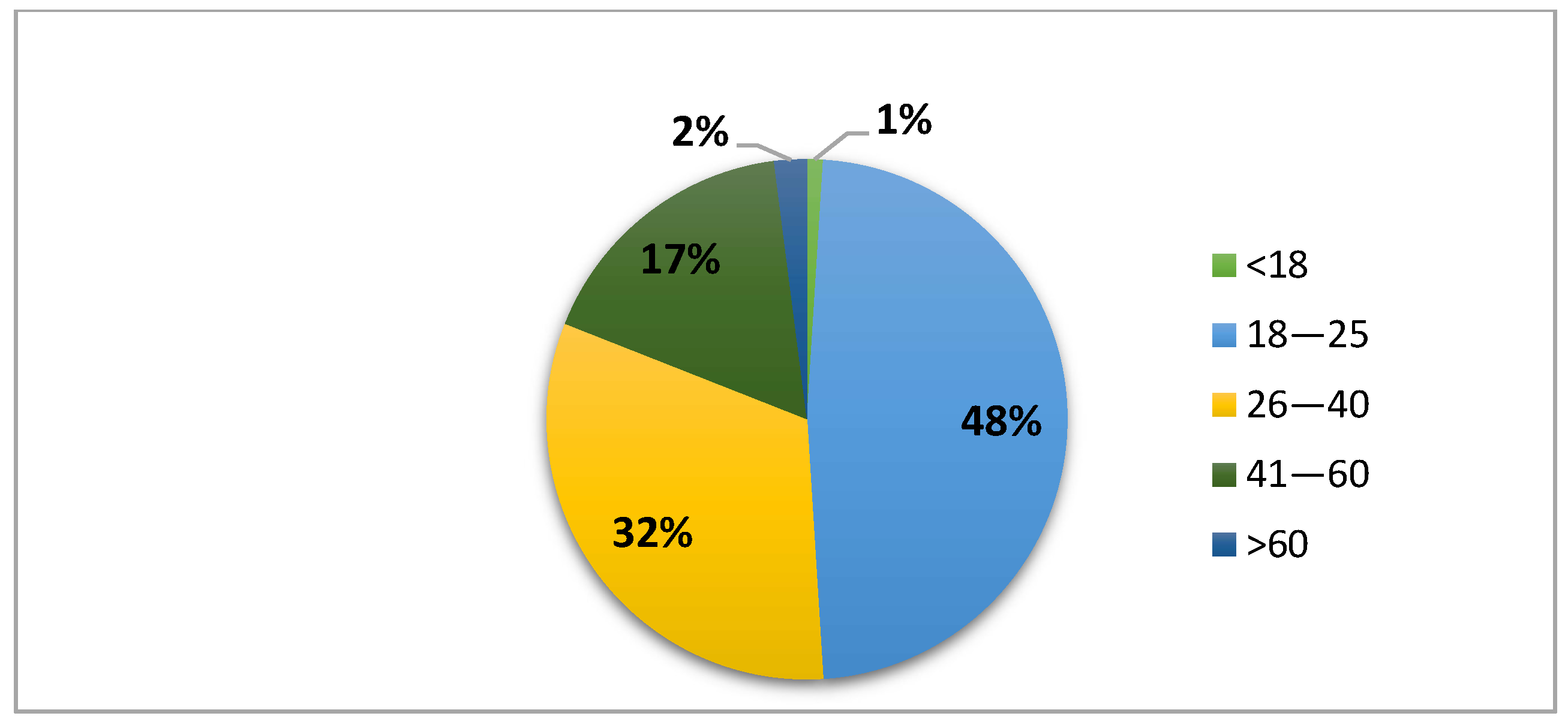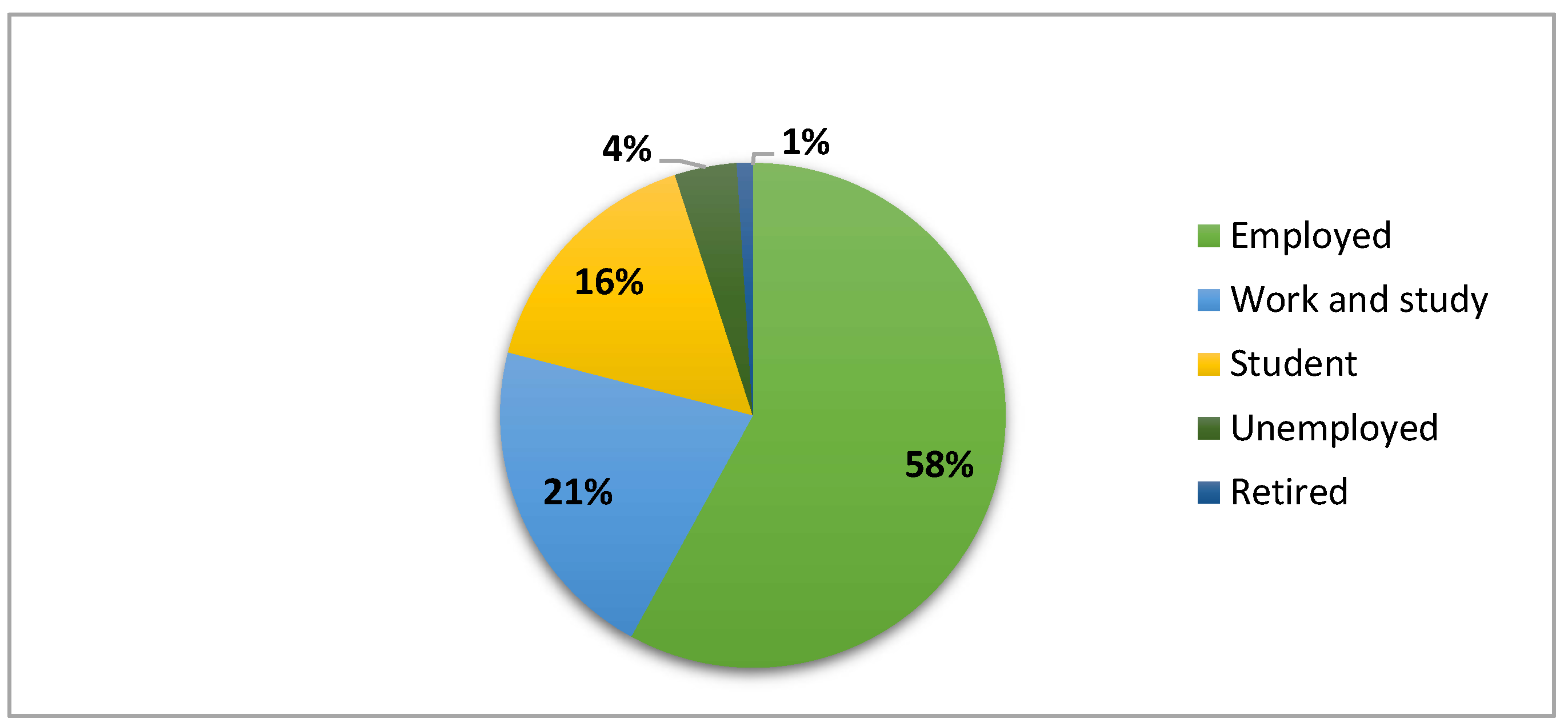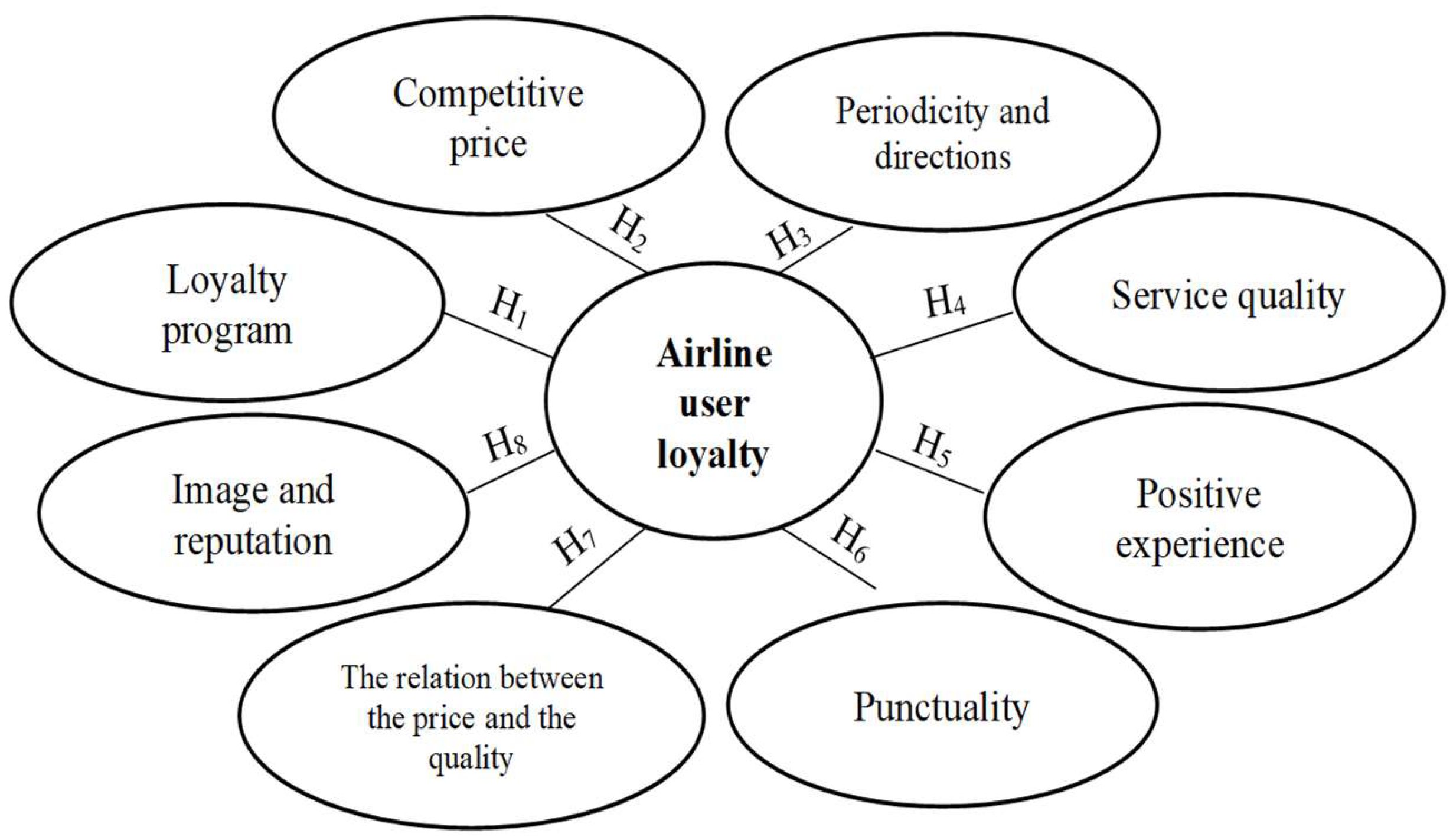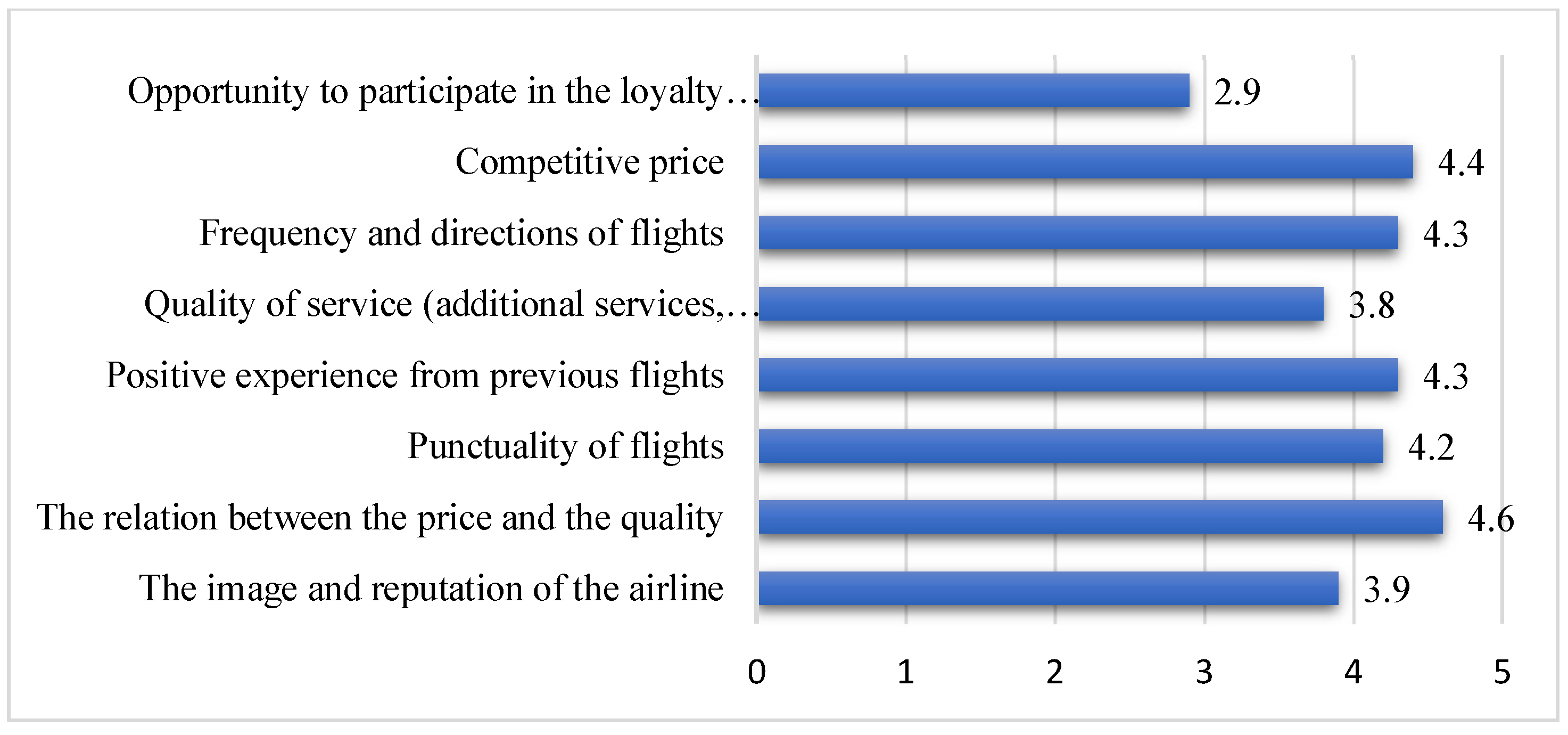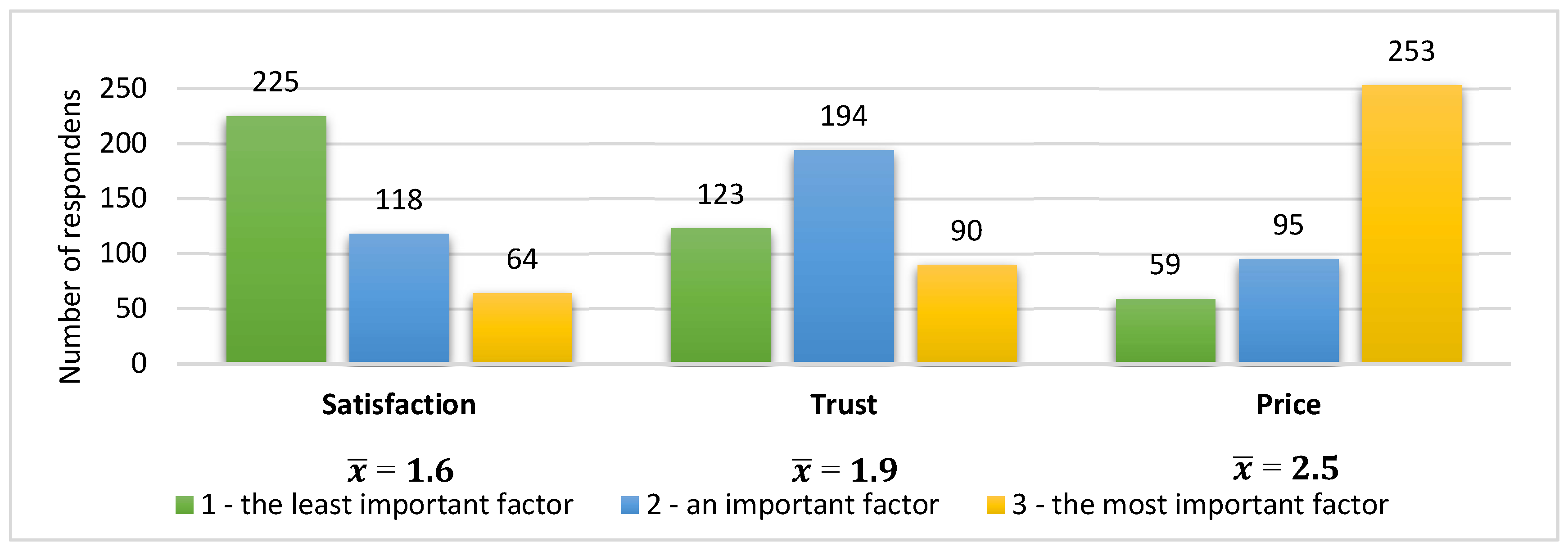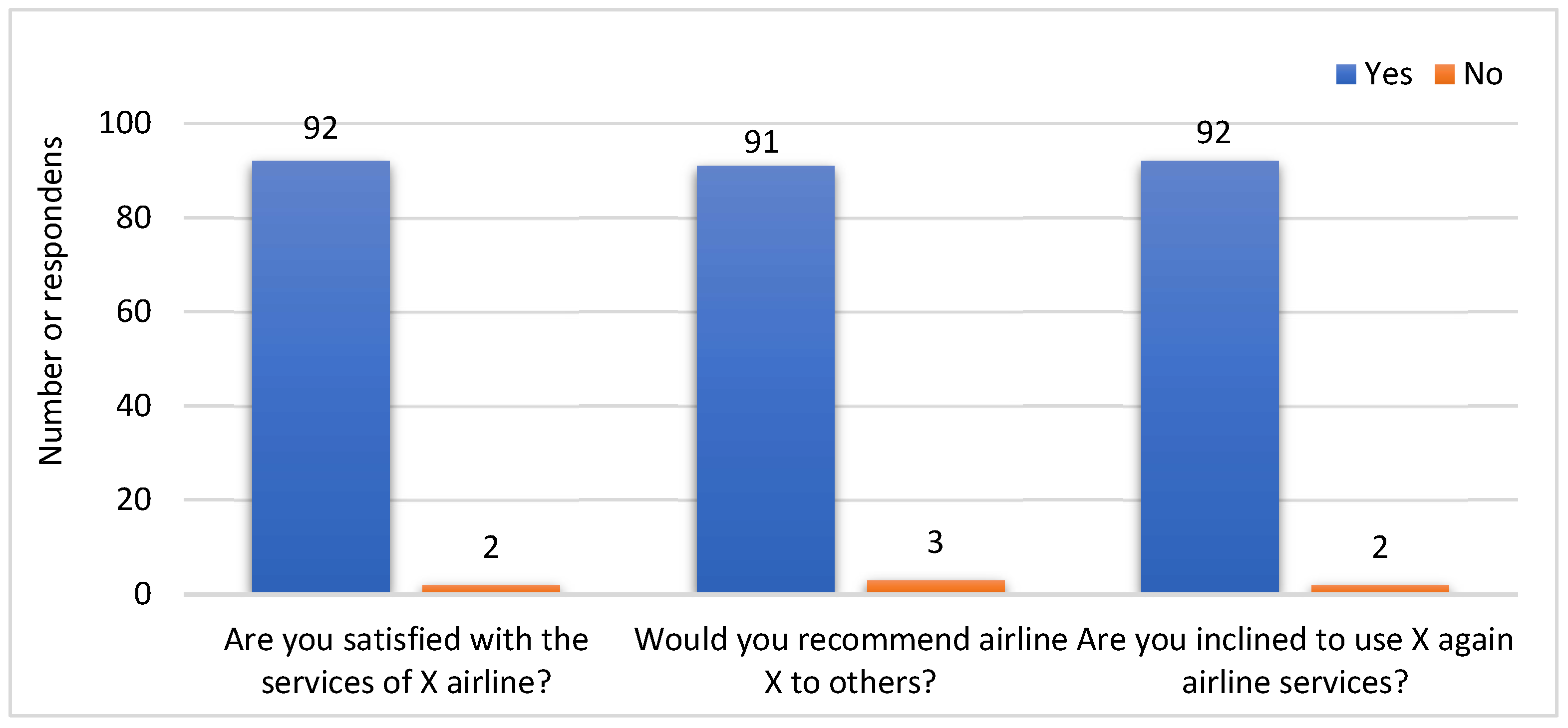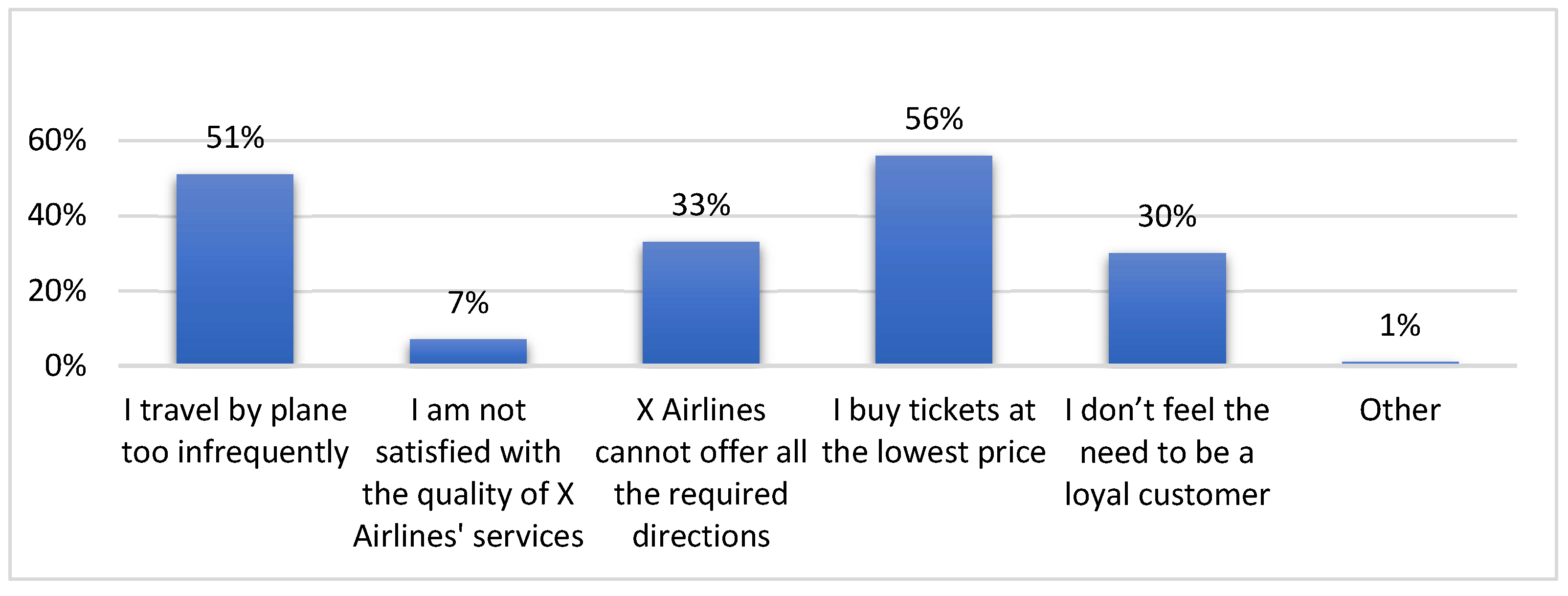1. Introduction
Aviation was one of the first industries in the world to actively promote consumer loyalty at the end of the last century while being highly affected by competition. The airline sector is characterized by the fact that there are limited barriers to exit from the market and, in many cases, there are many alternatives from which customers can choose to meet their needs; thus, airlines face a major challenge in properly analyzing passengers’ needs and expectations as well as identifying the factors that most promote their loyalty.
The topic of airline consumer loyalty has been quite widely discussed among various researchers [
1,
2,
3,
4,
5,
6] worldwide, to identify the factors that most promote consumer loyalty. However, there are conflicting opinions among different researchers about the impact of certain factors on customer loyalty; therefore, not all airline loyalty programs provide the expected benefits to airlines. According to 2017 data, only 6% of all airline passengers in the world participated in loyalty programs [
6,
7], which is a relatively low percentage, showing that airlines often underestimate the factors that are most important in determining passenger loyalty.
The objective of the manuscript is to identify and to analyze the factors that have the greatest impact on airline passengers’ loyalty, based on a study carried out on 409 passengers of two classes: prestige (business) and economy, traveling from Lithuania airports to other countries.
This research article is structured as follows. The second section presents the brief theoretical background of passengers. The third section is for methodology of the research, including details about participants, measures, and the procedure used in the study; this section is followed by results and discussion. Future research and limitations are given next, with the conclusion as the last section.
Originality—this research study is not a case study and its findings can provide meaningful implications for the management of airline service elements with regard to perceived value for money, passenger satisfaction, and passenger loyalty. Based on the literature review of the drivers of airline loyalty from other researchers, a model was developed with eight hypothesized statements that were confirmed or disproved in this study.
2. Literature Review and Research Background
In 1990, for the first time, more than one billion (1.025 billion) passengers were carried by airlines around the world. A quarter of a century after that historical mark, worldwide, airlines served 3.696 billion travelers in 2016 [
8]. As demands grow, requests for air service quality are also on the rise. Thus, numerous studies have been conducted to examine passenger evaluations of airline service in order to improve their quality and to win over passenger satisfaction and loyalty. Additionally, many researchers have studied service quality and tried to identify the factors that affect customer satisfaction and loyalty in various industries to increase service performance [
9,
10,
11]. However, there is a paucity of research on the service quality of the airline industry, despite the fact that the airline industry traditionally has a high level of competition, a situation that causes airline companies to strive to find ways to improve their service quality to gain a competitive advantage.
Scientific sources reveal a wide variety of factors that promote airline customer loyalty. Although several researchers [
12,
13,
14] argue that price is one of the most important factors, scholarly articles reveal conflicting views on the impact of the price on consumer loyalty. It should be noted that for infrequent passengers, the most important factor in choosing an airline is price, which leads to frequent switching of operators and complete infidelity. This can also be explained by studies demonstrating that young and older people (i.e., usually with relatively low incomes) are the most likely to choose low-cost airlines, since price has a significant impact on them [
15,
16]; thus, it can be stated that customers of low-cost airlines are particularly sensitive to price changes [
14,
17,
18]. Other authors state that price does not have a significant effect, and those consumers whose choice of the airline is little influenced by the price (less than 3% of all factors assessed) have the highest loyalty to a particular airline [
13,
19], as they focus on the value, quality, and satisfaction of the service and the assurance of the future service [
20,
21].
However, the price–quality ratio is an important factor in consumer choice in each segment [
16]; thus, it can be stated that a fair and rationally set price for an airline service is a very important factor for the customer, often determining his level of loyalty. This may be based on the fact that the consumer is seeking an economic benefit for himself, and an unreasonable price may lead to his disappointment.
The services provided by airlines are unique in that loyalty factors also differ in each market segment [
22]; however, in general, loyalty is affected by three interrelated elements: perceived value, satisfaction, and trust [
17]. According to the authors [
17], satisfaction is felt by airline consumers when the perceived value of the service is as expected or even higher, which builds trust and fosters loyalty.
The most commonly analyzed element of attitude and behavioral loyalty in the scientific literature is satisfaction, which is described as one of the key mechanisms to be used in order to retain existing customers, and any discussion of loyalty should include a thorough analysis of customer satisfaction [
17,
22]. Some researchers [
23] have revealed that airline customer satisfaction is mostly influenced by airline reliability, while the results of customer satisfaction and loyalty surveys by others [
16,
24] showed that customer satisfaction is most dependent on crew helpfulness and professionalism, level of flight service, atmosphere, and price–quality ratio.
Although many researchers see a strong direct relationship between loyalty and satisfaction [
15,
16,
25,
26,
27,
28], others state that satisfaction is not a necessary condition of loyalty because satisfied customers often do not return. In this case, preference is given to price and then to loyalty programs [
13,
29]. The application of loyalty programs or other privileges granted to loyal customers often influences the choice of airline; however, there is debate as to whether membership in loyalty programs promotes loyalty to the program alone or to the company as a whole [
30].
According to several researchers [
7,
12], the choice and loyalty of airline consumers is influenced not only by price, satisfaction, quality of service, sense of security, etc., but also by the airline’s flight network, schedule convenience, choice of seats on the plane, boarding or flight times, etc. Research conducted by other researchers [
12,
22] found that customer loyalty is also affected by service quality, airline reputation, and safety and security. In terms of safety and security, research [
23] has shown that flight safety and security have a significant impact on leisure travelers who are less likely to fly, and that these aspects are less pronounced among frequent or business/educational travelers due to the need or habit of flying. Given the views expressed by different scholars on the factors influencing airline choice and loyalty, it can be noticed that there are many different opinions on which factors have the greatest impact on loyalty and, more generally, on the importance of certain factors. The insights provided by different authors in the scientific literature are summarized in
Table 1.
Considering the findings of previous research studies [
10,
28,
29,
33], it is expected that air passengers may have different evaluations of the service quality of airlines of different rankings (e.g., low- vs. high-ranked airlines) and of different cabin types (e.g., business vs. economy). In addition, taking hints from other research [
7,
33,
34,
35,
36,
37], it appears relevant to assume that passengers on direct flights may have different evaluations of air service quality compared to those on connecting flights since the latter have to go through more hassle and have greater need for pre- and in-flight services.
Moreover, from other authors’ research on the loyalty of paratransit users, it can be concluded that loyalty is positively influenced by satisfaction [
38]. Satisfaction with paratransit’s image and unique attributes sustains passengers’ future loyalty intentions, depending on passengers’ current personal characteristics (i.e., age, income, occupation) and trip characteristics (e.g., fare, vehicle ownership). This study [
38] warns of the high probability of a mode shift from paratransit to another mode.
There is some evidence on how airline catering and its dimensions affect customer loyalty formation procedure and behavior towards airline products. One study was designed to find out the formation procedure of airline customer loyalty by revealing the specific role of airline meals and their dimensions, attitude, satisfaction, and affection [
39].
In summary, different authors express different opinions on what factors are crucial to ensure loyalty. Loyalty to an airline is determined by the specifics of the services provided by the airlines, the quality of the service, the image, the reputation, the loyalty programs, the value perceived by the consumer over the price, satisfaction, and trust. Each consumer group is different in terms of needs and level of loyalty, so when developing different loyalty models, it becomes important for airline marketing professionals to analyze their potential customers well and not necessarily apply a universal model, but rather a tailor-made, individual offer to a specific consumer group.
3. Methodology of Research
In view of the problem identified in the analysis of the scientific literature that there is no common approach to the factors that have the greatest influence on the choice of airline consumers, a quantitative statistical research method was applied. The questionnaire survey is popular in social research, because proper preparation and use of the research questionnaire can provide sufficient adequate information about the research phenomenon [
40]. The questionnaire is considered to be the main method for assessing the expected consumer loyalty [
19].
Quantitative data collection was chosen as the research method - a questionnaire survey. An electronic questionnaire using the Google Forms tool was prepared in advance for the research. The research environment was natural, and the questionnaire was publicized online - in different Facebook public and private groups, on a LinkedIn account, the questionnaire was sent privately to friends, acquaintances, and random people. The questionnaire consists of closed-ended questions, and the structure consists of introductory, followed by demographic-social and diagnostic sections. The survey was conducted in the fall of 2021.
The research report consists of conclusions from the data, logical substantiation, workflow, and discussion [
41]. The obtained data were processed by performing statistical data analysis, applying descriptive statistics and graphical data representation, using Microsoft Excel program. Based on the method of descriptive statistics, the frequencies of variables were calculated in order to observe the most frequently or rarely recurring properties, position, and scattering characteristics of the dataset [
42]. It should be noted that questionnaires that were not fully completed were rejected and not analyzed to avoid distorting the results of the research.
The selection of respondents was carried out at random, selecting the population of people traveling by air through Lithuanian airports. The research focuses on the Lithuanian population.
The minimum research sample was calculated according to the following formula [
43]:
where n is the the sample size, ∆ is the the sample error or the limit of sampling (a 5% error is applied in social sciences research, i.e., ∆ = 0.05), and N is the size of the population.
In 2019, 6.5 million people were served at Lithuanian airports (Vilnius—5.00 million, Kaunas—1.16 million, Palanga—0.34 million); therefore, it can be considered a survey population, as the attitudes of Lithuanian airline consumers towards loyalty are being analyzed. Calculations using the Paniotto formula showed that the sample must be at least 400 inhabitants:
The sampling characteristics of the respondents must meet the condition that the person has flown to/from Lithuania at least once during the last 2 years. To this end, a question was asked at the beginning of the questionnaire: “Have you flown to/from Lithuanian airports in the last 2 years?”. Those who answer “Yes” were the respondents of the survey who were asked other questions of the questionnaire, and those who answer “No” were excluded from the survey.
This study analyzed the data from passengers of two classes: prestige (business) and economy. Data were collected from passengers who traveled from Lithuania airports (Vilnius, Kaunas, Palanga) to other countries. A total of 431 people participated in the quantitative survey, of which the selective question “Have you flown to/from Lithuanian airports in the last 2 years?” was positively answered by 409 people, of whom 136 were men (33%) and 273 women (67%).
The scientific literature states that women are considered to be superior in communication and have a stronger loyalty to the service organization [
19], as well as that loyalty differs at different stages of life [
44]; therefore, age has a significant impact on consumer loyalty. Older people are generally said to be more loyal, but in the passenger transport sector, on the contrary, younger people are more loyal. Complementing the impact of demographic and social characteristics on loyalty in scientific sources, it is unequivocally stated that people with lower education and lower incomes are more loyal to service providers because they do not show a tendency to accumulate and compare more information [
44,
45].
The results of the quantitative survey and the general conclusions of the research are presented further.
4. Research Results
The survey found that the vast majority of respondents belonged to the 18–25 age group (48%), a smaller share (32%) were 26–40 years old, and 17% were 41–60 years old. The smallest share was made up of persons under 18 years old (1%) and those over 60 years old (2%); therefore, it is considered that minors and the elderly are characterized by low activity and, most likely, disloyalty to airlines (
Figure 1).
Respondents were asked to indicate their education. As many as 49% of respondents had a university degree and 18% had started but not yet completed university. Of the respondents, 12% had graduated from college and completed non-university higher education, and 5% were still pursuing it; 10% of respondents had secondary education, and 6% had vocational education (
Figure 2).
Of the respondents, 325 answered that they were employed, which is 79% of all respondents. Of these 79%, 58% were employed alone, and 21% performed work and study at the same time. Of the respondents, 16% were only studying, 4% were unemployed, and 1% were retired. This distribution provides a rationale for the research, as airline user loyalty can be assured when consumers work and receive a stable income that they can spend on repeated trips (
Figure 3).
The survey sought to find out the respondents’ opinion about the factors influencing the choice of the airline by providing them with eight statements, which the respondents had to evaluate on a five-point scale (indicating for each statement the degree of agreement or disagreement with the significance of the factor). Higher rating of statements (4 for “important” or 5 for “very important”) on the Likert scale indicated strong positive attitudes of the respondent, and a lower rating (1 for “completely not important” or 2 for “not important”) indicated negative attitudes. A rating of “neither important nor not important” (3) indicated a neutral opinion of the respondent.
In order to assess the importance of individual factors, the average importance of factors for all respondents was calculated using Equation (3):
where
v1—the number of cases for determining the factor in the first place,
v2—the number of cases for determining the factor in the second place,
v3—the number of cases for determining the factor in the third place,
v4—the number of cases for determining the factor in the fourth place,
v5—the number of cases for determining the factor in the fifth place, and
n—study sample (409).
The average response of the respondents was calculated, which showed that the choice of the airline was mainly influenced by the price of the ticket, the convenience of the schedule and directions, and the reputation, safety, and security of the airline. In addition, the interior of the plane had the least influence on the choice of the airline. Quality of service, food, and drink and the design and convenience of the websites or mobile applications were most often assessed by respondents as neutral factors (
Figure 4).
After assessing the factors that, in general, determine the choice of respondents, it is important to assess what most determines the current or potential loyalty of consumers, i.e., the conditions under which a favorable attitude of the consumer towards the airline and the repeated purchase of services would be ensured. Based on the factors promoting loyalty to airlines identified by other researchers in the review of the scientific literature, a model with eight hypothetical statements was developed that needs to be either confirmed or refuted in this research:
H1: Opportunity to participate in the loyalty program has an impact on increasing consumer loyalty.
H2: Competitive prices for tickets and other services have an impact on increasing consumer loyalty.
H3: The frequency and direction of flights have an impact on increasing customer loyalty.
H4: The quality of service (crew professionalism, additional services, positive atmosphere) has an impact on increasing customer loyalty.
H5: The positive experience of previous flights has an impact on increasing consumer loyalty.
H6: Punctuality of flights has an impact on increasing customer loyalty.
H7: The price–quality ratio has an impact on increasing consumer loyalty.
H8: The airline’s image and reputation have an impact on increasing consumer loyalty.
A hypothetical model of airline consumer loyalty is presented in
Figure 5.
The consumer survey revealed that the loyalty of the Lithuanian population is most affected by the price–quality ratio and competitive prices. In addition, the respondents attached great importance to the frequency of flights and directions, positive experience of previous flights, and punctuality of flights. It is noticeable that loyalty from the consumer perspective can be ensured when all these eight conditions are met; however, the opportunity to participate in loyalty programs has the least impact on the Lithuanian population (most respondents chose neutral and negative assessment). This may be due to the fact that airline loyalty programs are not very popular and the frequency of passenger flights is too low (
Figure 6).
Summarizing the obtained results, it can be stated that all hypothetical statements are confirmed, because the averages of all factors are equal to important and very important estimates. It is noted that the first hypothetical statement about the impact of loyalty programs on consumer loyalty is only partially confirmed, because the average obtained is equal to the neutral opinion of the respondents.
An analysis of the scientific literature revealed a number of conflicting scientific opinions on the impact of three key factors - satisfaction, trust, and price - on the loyalty of airline consumers. Respondents were asked to rank these three factors in order of their loyalty in ascending order (1 to 3).
During the survey, the results were distributed in a trend - most respondents indicated the price as the most important factor, trust as the important factor, and satisfaction as the least important factor. This is also reflected in the obtained values of the average estimates of the importance of factors: satisfaction rating - 1.6, trust - 1.9, and prices - 2.5 (
Figure 7).
Considering that price has the biggest impact when Lithuanians choose an airline, the model of promoting the loyalty of airlines operating in Lithuania must first include always competitive prices and ensure the basic quality of services corresponding to the price. Passengers do not give too much importance to the exceptional quality and satisfaction of the service due to infrequent travel; therefore, in order to ensure customer loyalty, a price that meets people’s needs, a sufficient supply of flights, and smooth and safe travel processes that ensure positive passenger attitudes must be guaranteed in the first place.
5. Analysis of the Reasons for Loyalty and Disloyalty
Examining the loyalty of the Lithuanian population to airlines and the general attitude towards it, they were first asked to answer the question “Are you loyal to a specific airline(s)?”. The results of this question have already been discussed in the analysis of the demographic and social characteristics of the respondents, where it turned out that only 23% of all respondents consider themselves loyal.
Of the respondents, 94 out of 409 consider themselves loyal airline consumers. These consumers are most valuable to companies because of their positive attitude towards airline services. It has been proposed that true loyalty can be measured by asking three questions:
During the survey, 89 respondents answered positively to all three questions; thus, only they can be considered as real airline loyal customers (
Figure 8). Two respondents answered two questions in the negative (one is dissatisfied with the service and unwilling to use it again, but does not refuse to recommend it to others, and the other is dissatisfied with the service and would not recommend it to others, but intends to use it again). The other two respondents answered only that they did not recommend to others, and one more respondent only intends to use it again. These respondents are hesitant about their loyalty.
The majority of respondents who consider themselves loyal (66%) are participants in airline loyalty programs, and 34%, although loyal, do not use loyalty programs and express their loyalty in a different way. Respondents who consider themselves disloyal (77% of all respondents) are more passive participants in loyalty programs. Of these, only 25% have memberships, and 75% do not have memberships (
Figure 9).
When respondents with memberships in loyalty programs were asked what motivated them to participate in loyalty programs, the majority (73–74% of all loyal respondents) indicated that they participate due to the benefits provided, which make the whole travel process more convenient and economic benefits. The main and most pronounced reason indicated by disloyal airline consumers with at least one membership is economic benefits. Among loyal consumers, the option that loyalty programs allow for a sense of exclusivity and other reasons not mentioned in the questionnaire received the fewest answers.
It should be noted that 34% of respondents who consider themselves loyal, however, do not participate in loyalty programs, and the main reasons for this are that they think they travel by plane too infrequently (56% of respondents) and do not want to commit (44%). Among disloyal customers, the main reason for nonparticipation, noted by 69% of people, is that they rarely travel by plane. Other respondents seek to avoid excessive advertising traffic by not participating in loyalty programs, while others feel that loyalty programs do not pay off for them.
The results of the reasons for participation in loyalty programs demonstrate that the main emphasis is on monetary and time-saving benefits, and the main reason for nonparticipation is rare travel of Lithuanians. When asked to suggest measures to improve loyalty programs, five loyal customers expressed their opinion:
Low-cost airline loyalty programs need to be improved to enable points to be accumulated and exchanged for other services.
Higher discounts must be applied to old customers.
The customer service department must work in a faster and nicer way, and not charge or charge less than ~2.5 EUR/min for a call.
Passengers must be encouraged by symbolic gifts and personal offers.
Depending on the current situation, all health protection measures must be ensured.
Other respondents who consider themselves loyal would participate in loyalty programs if they offered more privileges (59% of respondents who are loyal but do not participate in the programs) and if points were accumulated and exchanged more easily (50%). Of the respondents, 34% pointed out that the content of loyalty programs needs to be more engaging; therefore, in order to attract loyal passengers, it is important to invest in modern and attractive points accumulation and the presentation of benefits.
Disloyal customers were asked to disclose what causes their disloyalty and what would lead them to become loyal to the airlines. The main reasons for the disloyalty were the fact that they buy tickets at the lowest price (without paying attention to the carrier) (56%) and that they travel by plane too infrequently (51%). Of the respondents, 33% are disloyal due to the fact that airlines cannot offer all the necessary directions, and 31% of respondents do not feel the need to be a loyal customer (
Figure 10). Only 7% of respondents consider themselves disloyal due to the fact that they are not satisfied with the quality of services; therefore, it can be stated that the Lithuanian population pays little attention to quality and pays most attention to the basic perception of the value of services.
When asked what would most encourage loyalty, more than half of respondents (59%) answered that it would be always competitive prices and flexibility; a smaller share of respondents (39%) emphasized a greater variety of destinations and frequency of flights. Of the respondents, 16% would not be encouraged by anything to become a loyal customer, and the extremely high quality of service would be an important incentive for only 22% of respondents; therefore, it can be stated that due to the rare travel by air, the price is more important than quality for the Lithuanian population, and satisfaction can be achieved only by ensuring a rational price–quality ratio.
6. Discussion
Consumer loyalty is a positive attitude of consumers towards a service provider, manifested in the repeated purchase (or intention to purchase) of a service, the transmission of recommendations, prioritization, a higher level of trust, and a lower perceived risk. Loyal customers are an important condition for an efficient and profitable company, thus ensuring customer loyalty is one of the key goals of airlines.
After analyzing the scientific literature [
9,
10,
11,
12,
16,
24], it was noticed that there are many opinions about the factors that most promote the loyalty of airline users, but in the airline industry, such a model of loyalty factors that combines the needs and expectations of members of different user groups has still not been established and applied. Airlines focus on the most profitable business customers, focusing their services and loyalty programs on them as much as possible, but pay little attention to other passengers and their retention. In markets that are not characterized by an abundance of business customers, it is important to identify the factors that drive the choices and loyalty of the remaining (nonbusiness) customers, and to include them accordingly in the development of a consumer attraction and loyalty strategy. This means that there is a lack of consensus in scientific sources regarding the aspects of airline loyalty, which encourages the need to study loyalty concepts more widely, as well as their practical application to airlines operating in Lithuania.
In limited markets (such as Lithuania), where the aviation sector is not widely developed and consumers’ propensity for loyalty is limited, airlines must operate with the premise that every customer is important. This means that strategy development must focus on customers who create both high and low value.
Given the price–quality ratio is singled out as a crucial condition for loyalty, airlines need to offer personalized offers to their consumers, which will ensure the interaction between price leadership and service differentiation (according to the type of consumer).
The influence of various factors on airline passenger loyalty is widely discussed in scientific sources, and the main factors are satisfaction, trust, dedication and responsiveness, perceived quality, price, as well as airline reputation, safety, and security, schedule convenience, flight network and periodicity, etc. Although all of these factors undoubtedly influence the formation of loyalty, there is still no consensus among scholars as to which of them is most important. Opinions here often differ on the aspects of satisfaction and price.
Our quantitative survey showed that only 23% of all respondents consider themselves loyal airline users, but real loyalty based on service satisfaction, and the tendency of consumers to recommend to others and use again is even lower - almost 22% of respondents.
The main factors that promote loyalty in this market are competitive price, frequency and direction of flights, positive experience of previous flights, and price–quality ratio.
A loyal airline customer has the following characteristics: usually a middle-aged, working, and higher-educated woman who earns the average monthly salary in Lithuania. Of loyal respondents, 40% travel for business/work, the rest for holidays or leisure.
The main tool used to build airline customer loyalty is loyalty programs that are maximally focused on the most profitable business customers. Airlines pay very little attention to the retention of the remaining passengers; therefore, after an analysis of the scientific literature, a problem was raised that the airline industry still lacks a model of loyalty factors and incentives that combines the needs and expectations of members of different consumer groups.
Thus, after analyzing the attitudes of Lithuanian airline consumers towards loyalty and loyalty programs, it can be noticed that the majority of consumers who consider themselves loyal have memberships in loyalty programs, mostly due to the services provided, which simplify the whole travel process, and for economic benefits. Although 77% of respondents consider themselves disloyal, 25% of them have memberships in airline loyalty programs for economic benefits (instant discounts). The main reason for people not participating in loyalty programs is that flights are too infrequent, so there is no need to participate due to lack of benefits. The survey of Lithuanian airline consumers revealed that the main ways to ensure loyalty are competitive prices and a greater variety of directions and time, which encourages consumers to not look for other alternatives.
In order to achieve consumer loyalty and efficiency, a strategy that is more customer-centric (strengthening interconnectedness) compared to sales and market growth must be developed and applied.
Considering that a small portion of Lithuanian airline consumers consider themselves loyal, it is proposed to apply different measures to serve loyal and potential loyal customers. Loyal customers are offered direct sales, constant personal information, coordination of travel processes, as well as VIP services and involvement in the airline’s operations. In addition, when forming the loyalty of other customers, it is proposed to create service packages according to the group of consumers and, applying the results of personal data analysis, to adapt the offers according to the expectations of each consumer.
To encourage potential loyal users, the inclusion of play elements in the program is proposed, which would include the promotion of personalized goals that incorporate relevant content, a simple principle, and real benefits.
Consumer involvement must be encouraged through differentiated rewards and attention. Consumers must be encouraged not only for purchases but also for other actions, and participation in programs or the use of special offers must be nonbinding - loyalty must be encouraged through emotional satisfaction.
7. Conclusions
The right price–quality ratio, competitive price, flight frequency and directions, and the positive experience of previous flights have the greatest impact on consumer loyalty. With these factors, the loyalty of the Lithuanian population to airlines is likely; however, not all companies operating in Lithuania can ensure this, thus the level of loyalty is limited.
Among the most important factors when choosing an airline for Lithuanian residents are the price of the ticket, the convenience of the schedule and directions, and the reputation of the airline, safety, and security. These factors may be directly related to respondents’ habit of traveling infrequently, and this is confirmed by the idea expressed in the review of the scientific literature that for infrequent passengers, reaching their destination safely, reliably, and inexpensively is more important than experiencing emotional satisfaction.
Summarizing the obtained results, it can be said that all the hypothesized statements are confirmed, since the averages of all factors are equal to important and very important estimates. It is noted that the first hypothetical statement about the influence of loyalty programs on consumer loyalty is only partially confirmed, as the obtained average is equal to the neutral opinion of the respondents.
It is noted that among the factors that promote loyalty to airlines, the opportunity to participate in loyalty programs is the least influential. This is due to the fact that respondents rarely travel by plane, and also to the fact that nonstandard loyalty programs applied by low-cost airlines limit respondents’ perception of the true model of promoting airline loyalty.
There are three key things airlines need to do to grow their loyal customer base: build user motivation through the airline’s unique mission and initiative, obtain full knowledge of the target consumer, and employ more personalized promotional and engagement elements that drive interest and engagement.
In the context of a global pandemic, airlines can build loyalty by minimizing stress to passengers. The most important aspects are the greatest possible flexibility, the application of security and safety measures, and the most responsible and accurate management and presentation of the information flow chaos.
This study was conducted in Lithuania, and the findings may not be generalizable to other geographical regions. Future work can solve this constraint by carrying out a cross-country comparison study with a more diversified pool of respondents from different countries, which will tell us more about the cultural influence on determinants of customer loyalty. However, this study included a small sample size, and the participants were approached via a convenience sampling technique. Accordingly, future studies might consider employing larger samples and implementing a stratified sampling method to obtain reliable and generalizable results.
